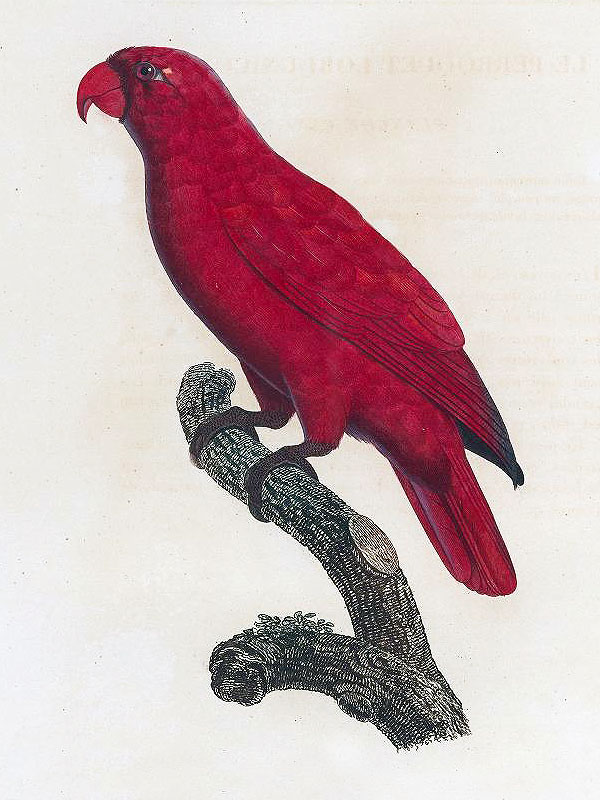The Unicolored Lory (Eos unicolor (Shaw)) is a bright red colored parrot, that is known from a single drawing and the annotated description in François Le Vaillant‘s ‚Histoire naturelle des perroquets‘ from the very early 19th century.
There were two individuals known at that time, kept in captivity in the Netherlands, from which one was depicted.:
„L’uniformité de la coleur du plumage de ce Lori nous a déterminé à lui donner le surnom d’unicolore; et cette coleur est d’un rouge pâle sur la tête, le cou, la poitrine, l’estomac, le ventre et les couvertures du dessous de la queue. Le manteau et le croupion, les couvertures des ailes et celles de la queue, lla queue elle-même, sont aussi rouges, mais d‘un noir brun vers leur pointe. Le bec est rouge, et les pieds sont d‘un brun terreux.
L’espèce de ce Lori se trouve aux Moluques. M. Temminck, d’Amsterdam, qui avoit deux de ces oiseaux dans sa belle collection, eut la bonté de m’en donner un. Ces deux individus sont les seuls de l’espéce que j’aie jamais vus.“
translation:
„The uniformity of the color of the plumage of this Lori has determined us to give him the moniker nickname; and this color is pale red on the head, neck, chest, stomach, belly, and undertail coverts. The mantle and the rump, the coverts of the wings and those of the tail, the tail itself, are also red, but of a dark brown towards their point. The beak is red, and the feet are of an earthy brown.
The species of this Lori is found in Maluku. M. Temminck from Amsterdam, who had two of these birds in his fine collection, was kind enough to give me one. These two individuals are the only ones of the species I have ever seen.“ [1]
***
The Maluku Islands were a Dutch colony (at least in parts), so it’s no wonder that birds cought there were transported to Amsterdam.
***
Since the Unicolored Lory is now known exclusively from the single drawing in ‚Histoire naturelle des perroquets‘, some zoologists think that this depiction may in fact simply show a Cardinal Lory (Chalcopsitta cardinalis (G. R. Gray)) from the Solomon Islands. This species, however, is not that unicolored but has a bright red underside and a rather dull cherry-red upper side, a longer tail, as well as a patch of bare skin around its beak.
The drawings made by Jacques Barraband are not just only very good, they are in fact scientifically correct, even for modern standards, so the Unicolored Lory can indeed be identified as a member of the genus Eos. This genus contains at least six species, that all are confined to the islands in the Banda Sea (the Maluku Islands and some islands off western New Guinea), Indonesia. All of these species are mainly bright red colored, with more or less amounts of bright blue areas.
There is a slight possibility that the two birds kept in captivity, were of hybrid origin, but this leads to the question for the parent species, since all other known congeneric species bear at least some blue in their plumage, while the Unicolored Lory was completely red.
The Maluku Islands, especially the smaller islands, are heavily deforested and the original forest has been replaced by plantations, this has probably already begun in the 14th century, when the islands were discovered by Arab merchants. Most of the endemic lory species are now heavily threatened with extinction, and at least two taxa (the Red-and-blue Lory (Eos histrio ssp. histrio (Statius Müller)), and the Talaud Red-and-blue Lory (Eos histrio ssp. talautensis Meyer & Wiglesworth)) are already completely extinct.
The Unicolored Lory may have been restricted to a single, small island within the region, and its population may already have been very low due to deforestation and hunting, when the two individuals were caught and brought to the netherlands
There is no obvious reason why the Unicolored Lory should not have existed!
*********************
References:
[1] François Le Vaillant: Histoire naturelle des perroquets, Paris Levrault, Schoell & Cie, An IX-XII 1801–1805
*********************

(public domain)
*********************
edited: 30.09.2018
